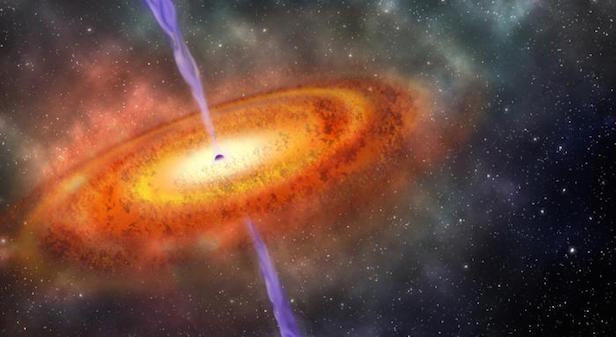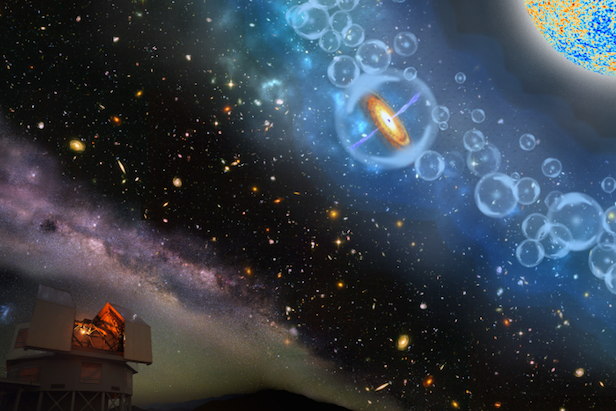Most distant black hole has been discovered
The supermassive object was observed just 680 million years after the Big Bang

The supermassive black hole is 800 times the mass of our Sun, which makes astronomers question the conditions of the early universe. Image credit: Carnegie Institution for Science
An ancient relic has been recently uncovered from the early universe – the farthest known supermassive black hole, buried in the essence of a quasar; an enormous 800 million times the mass of the Sun, which is unexpectedly large for such a young object.
Quasars are incredibly bright and distant galaxies that accommodate a supermassive black hole at the centre continuously accreting mass. The light from this quasar comes from a period where the universe was just 690 million years old. On a cosmic scale, this is very soon after the Big Bang, as the universe was only five per cent its current age.
“This black hole grew far larger than we expected in only 690 million years after the Big Bang, which challenges our theories about how black holes form,” says Daniel Stern of NASA’s Jet Propulsion Laboratory in Pasadena, California.
To have such an unexpectedly large black hole so soon after the Big Bang, astronomers have speculated that there must have been some special conditions in this period to allow the creation of black holes as massive as 100,000 times the mass of the Sun. No such thing would be seen in the present-day universe, as the black hole now rarely exceed a few dozen solar masses.
“Quasars are among the brightest and most distant known celestial objects and are crucial to understanding the early universe,” says Bram Venemans of the Max Planck Institute for Astronomy in Germany.

The light from this quasar travelled for over 13 billion years to reach our telescopes. Image credit: Carnegie Institution for Science
After the Big Bang, the universe was just a dense, hot blob of energetic particles. But as the universe expanded and cooled down, taking roughly 400,000 years, these particles began to form neutral hydrogen molecules. It was at this point that astronomers refer to as the ‘Dark Ages’, as the universe was pitch black due to the lack of luminous sources. When the first stars and galaxies began to form, they’re primordial energy began stripping the neutral hydrogen of their electrons, also known as ionisation. The gas has remained in that state since that time. After this reionisation, photons could travel freely throughout space, making the universe transparent to light.
Much of the surrounding hydrogen around the newly discovered quasar appears to be neutral. This means that this quasar is the only object that can be seen before the universe became ionised. Eduardo Bañados of Carnegie Institution for Science says, “It was the universe’s last major transition and one of the current frontiers of astrophysics.”
The distance to this quasar was measured based on the object’s redshift. This is a concept that measures how much the wavelength of its light has been stretched caused by the expansion of the universe. The more stretching, the greater distance, and therefore we are looking at it from a younger period in the development of the universe. This quasar has a redshift of 7.54; detecting the ionised carbon emitted from the galaxy made this discovery possible.
“This great distance makes such objects extremely faint when viewed from Earth. Early quasars are also very rare on the sky and have only been known to exist at a redshift greater than seven before now, despite extensive searching,” says Xiaohui Fan of the University of Arizona’s Steward Observatory.
Astronomers believe that between 20 and 100 quasars, as bright and as distant as this example, exist within the night sky. With the help of the European Space Agency’s future Euclid mission and NASA’s Wide-Field Infrared Survey Telescope (WFIRST), astronomers hope to discover more of these distant targets.
Keep up to date with the latest reviews in All About Space – available every month for just £4.99. Alternatively you can subscribe here and make the most of our Christmas offer for a fraction of the price!




